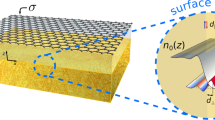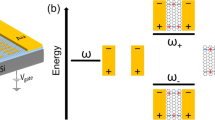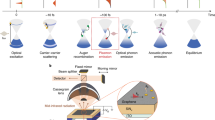Abstract
Plasmon is the quantum of the collective oscillation of electrons. How plasmon loses its energy (or damping) plays a pivotal role in plasmonic science and technology. Graphene plasmon is of particular interest, partly because of its potentially low damping rate. However, to date, damping pathways have not been clearly unravelled experimentally. Here, we demonstrate mid-infrared (4–15 µm) plasmons in graphene nanostructures with dimensions as small as 50 nm (with a mode area of ∼1 × 10−3 µm2). We also reveal damping channels via graphene intrinsic optical phonons and scattering from the edges. Plasmon lifetimes of 20 fs or less are observed when damping via the emission of graphene optical phonons is allowed. Furthermore, surface polar phonons in the SiO2 substrate under graphene nanostructures lead to a significantly modified plasmon dispersion and damping, in contrast to the case of a nonpolar diamond-like-carbon substrate. Our study paves the way for applications of graphene in plasmonic waveguides, modulators and detectors from sub-terahertz to mid-infrared regimes.
This is a preview of subscription content, access via your institution
Access options
Subscribe to this journal
Receive 12 print issues and online access
$209.00 per year
only $17.42 per issue
Buy this article
- Purchase on Springer Link
- Instant access to full article PDF
Prices may be subject to local taxes which are calculated during checkout




Similar content being viewed by others
References
Maier, S. Plasmonics: Fundamentals and Applications 1st edn (Springer, 2007).
Koppens, F. H. L., Chang, D. E. & Garcia de Abajo, F. J. Graphene plasmonics: a platform for strong light–matter interactions. Nano Lett. 11, 3370–3377 (2011).
Vakil, A. & Engheta, N. Transformation optics using graphene. Science 332, 1291–1294 (2011).
Ju, L. et al. Graphene plasmonics for tunable terahertz metamaterials. Nature Nanotech. 6, 630–634 (2011).
Fei, Z. et al. Infrared nanoscopy of Dirac plasmons at the graphene/SiO2 interface. Nano Lett. 11, 4701–4705 (2011).
Fei, Z. et al. Gate-tuning of graphene plasmons revealed by infrared nano-imaging. Nature 487, 82–85 (2012).
Chen, J. et al. Optical nano-imaging of gate-tunable graphene plasmons. Nature 487, 77–81 (2012).
Yan, H. et al. Tunable infrared plasmonic devices using graphene/insulator stacks. Nature Nanotech. 7, 330–334 (2012).
Yan, H. et al. Infrared spectroscopy of tunable Dirac terahertz magneto-plasmons in graphene. Nano Lett. 12, 3766–3771 (2012).
Han, M. Y., Ozyilmaz, B., Zhang, Y. & Kim, P. Energy band-gap engineering of graphene nanoribbons. Phys. Rev. Lett. 98, 206805 (2007).
Berger, C. et al. Electronic confinement and coherence in patterned epitaxial graphene. Science 312, 1191–1196 (2006).
Todd, K., Chou, H. T., Amasha, S. & Goldhaber-Gordon, D. Quantum dot behavior in graphene nanoconstrictions. Nano Lett. 9, 416–421 (2008).
Kreibig, U. & Vollmer, M. Optical Properties of Metal Clusters 1st edn (Springer, 1995).
Link, S. & El-Sayed, M. A. Size and temperature dependence of the plasmon absorption of colloidal gold nanoparticles. J. Phys. Chem. B 103, 4212–4217 (1999).
Li, X. et al. Large-area synthesis of high-quality and uniform graphene films on copper foils. Science 324, 1312–1314 (2009).
Wu, Y. et al. High-frequency, scaled graphene transistors on diamond-like carbon. Nature 472, 74–78 (2011).
Kucírková, A. & Navrátil, K. Interpretation of infrared transmittance spectra of SiO2 thin films. Appl. Spectrosc. 48, 113–120 (1994).
Yan, H. et al. Infrared spectroscopy of wafer-scale graphene. ACS Nano 5, 9854–9860 (2011).
Fuchs, R. & Kliewer, K. L. Optical modes of vibration in an ionic crystal slab. Phys. Rev. 140, A2076–A2088 (1965).
Dubois, L. H. & Schwartz, G. P. Surface optical phonons and hydrogen chemisorption on polar and nonpolar faces of GaAs, InP, and GaP. Phys. Rev. B 26, 794–802 (1982).
Matz, R. & Luth, H. Conduction-band surface plasmons in the electron-energy-loss spectrum of GaAs(110). Phys. Rev. Lett. 46, 500–503 (1981).
Wang, S. Q. & Mahan, G. D. Electron scattering from surface excitations. Phys. Rev. B 6, 4517–4524 (1972).
Fratini, S. & Guinea, F. Substrate-limited electron dynamics in graphene. Phys. Rev. B 77, 195415 (2008).
Hwang, E. H., Sensarma, R. & Das Sarma, S. Plasmon–phonon coupling in graphene. Phys. Rev. B 82, 195406 (2010).
Liu, Y. & Willis, R. F. Plasmon–phonon strongly coupled mode in epitaxial graphene. Phys. Rev. B 81, 081406 (2010).
Stern, F. Polarizability of a two-dimensional electron gas. Phys. Rev. Lett. 18, 546–548 (1967).
Wunsch, B., Stauber, T. & Guinea, F. Dynamical polarization of graphene at finite doping. New J. Phys. 8, 318 (2006).
Hwang, E. H. & Das Sarma, S. Dielectric function, screening, and plasmons in two-dimensional graphene. Phys. Rev. B 75, 205418 (2007).
Mikhailov, S. A. & Savostianova, N. A. Microwave response of a two-dimensional electron stripe. Phys. Rev. B 71, 035320 (2005).
Nikitin, A. Yu, Guinea, F., Garcia-Vidal, F. J. & Martin-Moreno, L. Surface plasmon enhanced absorption and suppressed transmission in periodic arrays of graphene ribbons. Phys. Rev. B 85, 081405 (2012).
Thongrattanasiri, S., Manjavacas, A. & Garcia de Abajo, F. J. Quantum finite-size effects in graphene plasmons. ACS Nano 6, 1766–1775 (2012).
Radovic, L. R. & Bockrath, B. On the chemical nature of graphene edges: origin of stability and potential for magnetism in carbon materials. J. Am. Chem. Soc. 127, 5917–5927 (2005).
Areshkin, D. A., Gunlycke, D. & White, C. T. Ballistic transport in graphene nanostrips in the presence of disorder: importance of edge effects. Nano Lett. 7, 204–210 (2006).
Fano, U. Effects of configuration interaction on intensities and phase shifts. Phys. Rev. 124, 1866–1878 (1961).
Jablan, M., Soljacic, M. & Buljan, H. Unconventional plasmon–phonon coupling in graphene. Phys. Rev. B 83, 161409 (2011).
Mahan, G. D. Many-Particle Physics 3rd edn (Kluwer Academic/Plenum, 2000).
Ferrari, A. C. et al. Raman spectrum of graphene and graphene layers. Phys. Rev. Lett. 97, 187401 (2006).
Hillenbrand, R., Taubner, T. & Keilmann, F. Phonon-enhanced light–matter interaction at the nanometre scale. Nature 418, 159–162 (2002).
Perebeinos, V. & Avouris, Ph. Inelastic scattering and current saturation in graphene. Phys. Rev. B 81, 195442 (2010).
Fischetti, M. V., Neumayer, D. A. & Cartier, E. A. Effective electron mobility in Si inversion layers in metal–oxide–semiconductor systems with a high-κ insulator: the role of remote phonon scattering. J. Appl. Phys. 90, 4587–4608 (2001).
Adato, R. et al. Radiative engineering of plasmon lifetimes in embedded nanoantenna arrays. Opt. Express 18, 4526–4537 (2010).
Jablan, M., Buljan, H. & Soljacic, M. Plasmonics in graphene at infrared frequencies. Phys. Rev. B 80, 245435 (2009).
Langer, T. et al. Plasmon damping below the Landau regime: the role of defects in epitaxial graphene. New J. Phys. 12, 033017 (2010).
Park, C-H., Giustino, F., Cohen, M. L. & Louie, S. G. Velocity renormalization and carrier lifetime in graphene from the electron–phonon interaction. Phys. Rev. Lett. 99, 086804 (2007).
Low, T. et al. Cooling of photoexcited carriers in graphene by internal and substrate phonons. Phys. Rev. B 86, 045413 (2012).
Ong, Z. & Fischetti, M. V. Theory of interfacial plasmon–phonon scattering in supported graphene. Phys. Rev. B 86, 165422 (2012).
Acknowledgements
The authors thank B. Ek, J. Bucchignano and S. (Jay) Chey for technical assistance, and V. Perebeinos and Z. Li of the National High Magnetic Field Laboratory and T.F. Heinz of Columbia University for discussions. F.X. thanks C. Gmachl of Princeton University and Y. Yao of Harvard University for help in the planning stage of the project. T.L. and F.G. acknowledge the hospitality of KITP, supported in part by the National Science Foundation (grant no. NSF PHY11-25915). T.L. also acknowledges partial support from NRI-INDEX, and F.G. is also supported by the Spanish MICINN (FIS2008-00124, CONSOLIDER CSD2007-00010) and ERC grant 290846.
Author information
Authors and Affiliations
Contributions
F.X. and H.Y. initiated the project and conceived the experiments. W.Z., Y.W., H.Y. and F.X. fabricated the devices. H.Y. performed the measurements and data analysis. T.L. and F.G. provided modelling and the theoretical foundation. M.F. participated in setting up the experimental apparatus. X.L. grew the CVD graphene. H.Y. and T.L. co-wrote the manuscript with input from F.X., and P.A. provided suggestions throughout the project. All authors commented on the manuscript.
Corresponding authors
Ethics declarations
Competing interests
The authors declare no competing financial interests.
Supplementary information
Supplementary information
Supplementary information (PDF 813 kb)
Rights and permissions
About this article
Cite this article
Yan, H., Low, T., Zhu, W. et al. Damping pathways of mid-infrared plasmons in graphene nanostructures. Nature Photon 7, 394–399 (2013). https://doi.org/10.1038/nphoton.2013.57
Received:
Accepted:
Published:
Issue Date:
DOI: https://doi.org/10.1038/nphoton.2013.57
This article is cited by
-
Ultra-wideband terahertz fingerprint enhancement sensing and inversion model supported by single-pixel reconfigurable graphene metasurface
PhotoniX (2024)
-
Compensating losses in polariton propagation with synthesized complex frequency excitation
Nature Materials (2024)
-
Planar hyperbolic polaritons in 2D van der Waals materials
Nature Communications (2024)
-
Mid-infrared analogue polaritonic reversed Cherenkov radiation in natural anisotropic crystals
Nature Communications (2023)
-
Hyperbolic whispering-gallery phonon polaritons in boron nitride nanotubes
Nature Nanotechnology (2023)



